Northern Ireland
Northern Ireland (Irish: Tuaisceart Éireann [ˈt̪ˠuəʃcəɾˠt̪ˠ ˈeːɾʲən̪ˠ] (![]()
Northern Ireland
| |
|---|---|
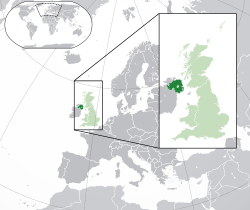 Location of Northern Ireland (dark green) – in Europe (green & dark grey) | |
| Status | Country (constituent unit) |
| Capital and largest city | Belfast 54°36′N 5°55′W |
| Languages[b] | English |
Regional languages |
|
| Ethnic groups (2011) | |
| |
| Government | Consociational devolved legislature within unitary constitutional monarchy |
• Monarch | Elizabeth II |
• First Minister | Arlene Foster |
• Deputy First Minister | Michelle O'Neill |
| Parliament of the United Kingdom | |
| • Secretary of State | Brandon Lewis |
| • House of Commons | 18 MPs (of 650) |
| Legislature | Northern Ireland Assembly |
| Devolution | |
| 3 May 1921 | |
| 18 July 1973 | |
| 17 July 1974 | |
| 19 November 1998 | |
| Area | |
• Total | 14,130 km2 (5,460 sq mi)[2] |
| Population | |
• 2019 estimate | |
• 2011 census | 1,810,863[4] |
• Density | 133/km2 (344.5/sq mi) |
| GVA | 2018 estimate |
| • Total | £49 billion[5] |
| • Per capita | £26,000 |
| HDI (2017) | 0.899[6] very high |
| Currency | Pound sterling (GBP; £) |
| Time zone | UTC (Greenwich Mean Time) |
| UTC+1 (British Summer Time) | |
| Date format | dd/mm/yyyy (AD) |
| Driving side | left |
| Calling code | +44[c] |
| ISO 3166 code | GB-NIR |
| |
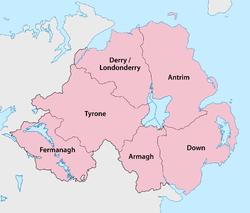
On 11 January 2020, legislators in Northern Ireland formed a government for the first time since the Executive of the 5th Northern Ireland Assembly collapsed in January 2017,[15] following the Renewable Heat Incentive scandal.
Northern Ireland was created in 1921, when Ireland was partitioned between Northern Ireland and Southern Ireland by the Government of Ireland Act 1920. Unlike Southern Ireland, which would become the Irish Free State in 1922, the majority of Northern Ireland's population were unionists, who wanted to remain within the United Kingdom.[16] Most of these were the Protestant descendants of colonists from Great Britain. However, a significant minority, mostly Catholics, were nationalists who wanted a united Ireland independent of British rule.[17][18][19][20] Today, the former generally see themselves as British and the latter generally see themselves as Irish, while a distinct Northern Irish or Ulster identity is claimed both by a large minority of Catholics and Protestants and by many of those who are non-aligned.[21]
For most of the 20th century, when it came into existence, Northern Ireland was marked by discrimination and hostility between these two sides in what First Minister of Northern Ireland, David Trimble, called a "cold house" for Catholics.[22] In the late 1960s, conflict between state forces and chiefly Protestant unionists on the one hand, and chiefly Catholic nationalists on the other, erupted into three decades of violence known as the Troubles, which claimed over 3,500 lives and injured over 50,000 others.[23][24] The 1998 Good Friday Agreement was a major step in the peace process, including the decommissioning of weapons and security normalisation, although sectarianism and religious segregation still remain major social problems, and sporadic violence has continued.[25]
The economy of Northern Ireland was the most industrialised of Ireland, declining as a result of the political and social turmoil of the Troubles,[26] but economically growing significantly since the late 1990s. The initial growth came from the "peace dividend" and the links which increased trade with the Republic of Ireland, continuing with a significant increase in tourism, investment and business from around the world. Unemployment in Northern Ireland peaked at 17.2% in 1986, dropping to 6.1% for June–August 2014 and down by 1.2 percentage points over the year,[27] similar to the UK figure of 6.2%.[28] More than 58% of those unemployed had been unemployed for over a year.
Cultural links between Northern Ireland, the rest of Ireland, and the rest of the UK are complex, with Northern Ireland sharing both the culture of Ireland and the culture of the United Kingdom. In many sports, the island of Ireland fields a single team, a notable exception being association football. Northern Ireland competes separately at the Commonwealth Games, and people from Northern Ireland may compete for either Great Britain or Ireland at the Olympic Games.
History
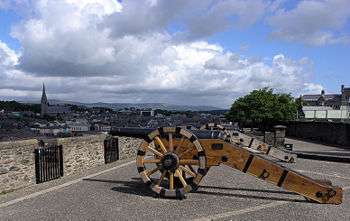
The region that is now Northern Ireland was the bedrock of the Irish war of resistance against English programmes of colonialism in the late 16th century. The English-controlled Kingdom of Ireland had been declared by the English king Henry VIII in 1542, but Irish resistance made English control fragmentary. Following Irish defeat at the Battle of Kinsale, though, the region's Gaelic, Roman Catholic aristocracy fled to continental Europe in 1607 and the region became subject to major programmes of colonialism by Protestant English (mainly Anglican) and Scottish (mainly Presbyterian) settlers. A rebellion in 1641 by Irish aristocrats against English rule resulted in a massacre of settlers in Ulster in the context of a war breaking out between England, Scotland and Ireland fuelled by religious intolerance in government. Victories by English forces in that war and further Protestant victories in the Williamite War in Ireland (1688–1691) toward the close of the 17th century solidified Anglican rule in Ireland. In Northern Ireland, the victories of the Siege of Derry (1689) and the Battle of the Boyne (1690) in this latter war are still celebrated by some Protestants (both Anglican and Presbyterian).[29][30]
Popes Innocent XI and Alexander VIII had supported William of Orange instead of his maternal uncle and father-in-law James II, despite William being Protestant and James a Catholic, due to William's participation in alliance with both Protestant and Catholic powers in Europe in wars against Louis XIV (the "Sun King"), the powerful King of France who had been in conflict with the papacy for decades. In 1693, however, Pope Innocent XII recognised James as continuing King of Great Britain and Ireland in place of William, after reconciliation with Louis. In 1695, and contrary to the terms of the Treaty of Limerick (October 1691), a series of penal laws were passed by the Anglican ruling class in Ireland in intense anger at the Pope's recognition of James over William, which was felt to be a betrayal. The intention of the laws was to materially disadvantage the Catholic community and, to a lesser extent, the Presbyterian community. In the context of open institutional discrimination, the 18th century saw secret, militant societies develop in communities in the region and act on sectarian tensions in violent attacks. These events escalated at the end of the century following an event known as the Battle of the Diamond, which saw the supremacy of the Anglican and Presbyterian Peep o'Day Boys over the Catholic Defenders and leading to the formation of the Anglican Orange Order. A rebellion in 1798 led by the cross-community Belfast-based Society of the United Irishmen and inspired by the French Revolution sought to break the constitutional ties between Ireland and Britain and unite Irish people of all religions. Following this, in an attempt to quell sectarianism and force the removal of discriminatory laws (and to prevent the spread of French-style republicanism to Ireland), the government of the Kingdom of Great Britain pushed for the two kingdoms to be merged. The new state, formed in 1801, the United Kingdom of Great Britain and Ireland, was governed from a single government and parliament based in London.
Some 250,000 people from Ulster emigrated to the British North American colonies between 1717 and 1775.[31] It is estimated that there are more than 27 million Scotch-Irish Americans now living in the United States,[32] along with many Scotch-Irish Canadians in Canada.
Partition of Ireland

During the 19th century, legal reforms started in the late 18th century continued to remove statutory discrimination against Catholics, and progressive programmes enabled tenant farmers to buy land from landlords. By the close of the century, a large and disciplined cohort of Irish Nationalist MPs at Westminster committed the Liberal Party to autonomy—"Home Rule"—for Ireland, a prospect bitterly opposed by Irish Unionists. In 1912, after decades of obstruction from the House of Lords, and with a Liberal government dependent on Nationalist support, Home Rule became a near-certainty. A clash between the House of Commons and House of Lords over a controversial budget produced the Parliament Act 1911, which enabled the veto of the Lords to be overturned. The House of Lords veto had been the unionists' main guarantee that Home Rule would not be enacted because the majority of members of the House of Lords were unionists. In response, opponents to Home Rule, from Conservative and Unionist Party leaders such as Bonar Law and Dublin-based barrister Sir Edward Carson to militant working class unionists in Ireland, threatened the use of violence. In 1914, they smuggled thousands of rifles and rounds of ammunition from Imperial Germany for use by the Ulster Volunteers (UVF), a paramilitary organisation opposed to the implementation of Home Rule.
Unionists were in a minority in Ireland as a whole, but in the northern province of Ulster they were a very large majority in County Antrim and County Down, small majorities in County Armagh and County Londonderry and a substantial minority in Ulster's five other counties.[33] The four counties named, along with County Fermanagh and County Tyrone, would later constitute Northern Ireland. Most of the remaining 26 counties which later became the Republic of Ireland were overwhelmingly majority-nationalist.
During the Home Rule Crisis, the possibility was discussed of a "temporary" partition of these six counties from the rest of Ireland. In 1914, the Third Home Rule Bill received Royal Assent as the Government of Ireland Act 1914. However, its implementation was suspended before it came into effect because of the outbreak of the First World War, and the Amending Bill to partition Ireland was abandoned. The war was expected to last only a few weeks but in fact, lasted four years. By the end of the war (during which the 1916 Easter Rising had taken place), the Act was seen as unimplementable. Public opinion among nationalists had shifted during the war from a demand for home rule to one for full independence. In 1919, David Lloyd George proposed a new bill be established by the cabinet's Walter Long Committee on Ireland, which by adopting findings of his (Lloyd George's) inconclusive 1917-18 Irish Convention would divide Ireland into two Home Rule areas: twenty-six counties being ruled from Dublin and six being ruled from Belfast. Straddling these two areas would be a shared Lord Lieutenant of Ireland who would appoint both governments and a Council of Ireland, which Lloyd George believed would evolve into an all-Ireland parliament.[34]
Events overtook the government. The pro-independence Sinn Féin won 73 of the 105 parliamentary seats in Ireland at the general election of 1918, and unilaterally established the First Dáil, an extrajudicial parliament in Ireland. Ireland was partitioned between Northern Ireland and Southern Ireland in 1921, under the terms of Lloyd George's Government of Ireland Act 1920,[35] during the Anglo-Irish War between Irish republican and British forces. A truce was established on 11 July; the war ended on 6 December 1921 with the signing of the Anglo-Irish Treaty, which created the Irish Free State. Under the terms of the treaty, Northern Ireland would become part of the Free State unless the government opted out by presenting an address to the king, although in practice partition remained in place.[36]
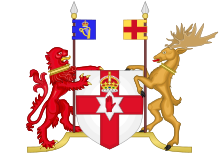
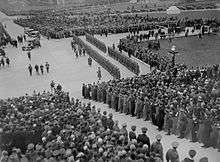
As expected, the Houses of the Parliament of Northern Ireland resolved on 7 December 1922 (the day after the establishment of the Irish Free State) to exercise its right to opt out of the Free State by making an address to the King.[37] The text of the address was:
Most Gracious Sovereign, We, your Majesty's most dutiful and loyal subjects, the Senators and Commons of Northern Ireland in Parliament assembled, having learnt of the passing of the Irish Free State Constitution Act 1922, being the Act of Parliament for the ratification of the Articles of Agreement for a Treaty between Great Britain and Ireland, do, by this humble Address, pray your Majesty that the powers of the Parliament and Government of the Irish Free State shall no longer extend to Northern Ireland.[38][39]
Shortly afterwards, the Boundary Commission was established to decide on the territorial boundaries between the Irish Free State and Northern Ireland. Owing to the outbreak of civil war in the Free State, the work of the commission was delayed until 1925. Leaders in Dublin expected a substantial reduction in the territory of Northern Ireland, with nationalist areas moving to the Free State. However, the commission's report recommended only that some small portions of land should be ceded from Northern Ireland to the Free State and even that a small amount of land should be ceded from the Free State to Northern Ireland. To prevent argument, this report was suppressed and, in exchange for a waiver to the Free State's obligations to the UK's public debt and the dissolution of the Council of Ireland (sought by the Government of Northern Ireland), the initial six-county border was maintained with no changes.
In June 1940, to encourage the neutral Irish state to join with the Allies, British Prime Minister Winston Churchill indicated to the Taoiseach Éamon de Valera that the United Kingdom would push for Irish unity, but believing that Churchill could not deliver, de Valera declined the offer.[40] The British did not inform the Government of Northern Ireland that they had made the offer to the Dublin government, and De Valera's rejection was not publicised until 1970.
The Ireland Act 1949 gave the first legal guarantee that the region would not cease to be part of the United Kingdom without the consent of the Parliament of Northern Ireland.
The Troubles
The Troubles, which started in the late 1960s, consisted of about 30 years of recurring acts of intense violence during which 3,254 people were killed[41] with over 50,000 casualties.[42] From 1969 to 2003 there were over 36,900 shooting incidents and over 16,200 bombings or attempted bombings associated with The Troubles.[43] The conflict was caused by the disputed status of Northern Ireland within the United Kingdom and the discrimination against the Irish nationalist minority by the dominant unionist majority.[44] From 1967 to 1972 the Northern Ireland Civil Rights Association (NICRA), which modelled itself on the US civil rights movement, led a campaign of civil resistance to anti-Catholic discrimination in housing, employment, policing, and electoral procedures. The franchise for local government elections included only rate-payers and their spouses, and so excluded over a quarter of the electorate. While the majority of disenfranchised electors were Protestant, Catholics were over-represented since they were poorer and had more adults still living in the family home.[45]
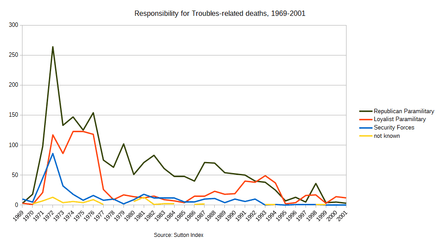
NICRA's campaign, seen by many unionists as an Irish republican front, and the violent reaction to it, proved to be a precursor to a more violent period.[46] As early as 1969, armed campaigns of paramilitary groups began, including the Provisional IRA campaign of 1969–1997 which was aimed at the end of British rule in Northern Ireland and the creation of a United Ireland, and the Ulster Volunteer Force, formed in 1966 in response to the perceived erosion of both the British character and unionist domination of Northern Ireland. The state security forces – the British Army and the police (the Royal Ulster Constabulary) – were also involved in the violence. The British government's position is that its forces were neutral in the conflict, trying to uphold law and order in Northern Ireland and the right of the people of Northern Ireland to democratic self-determination. Republicans regarded the state forces as combatants in the conflict, pointing to the collusion between the state forces and the loyalist paramilitaries as proof of this. The "Ballast" investigation by the Police Ombudsman has confirmed that British forces, and in particular the RUC, did collude with loyalist paramilitaries, were involved in murder, and did obstruct the course of justice when such claims had been investigated,[47] although the extent to which such collusion occurred is still hotly disputed.
As a consequence of the worsening security situation, autonomous regional government for Northern Ireland was suspended in 1972. Alongside the violence, there was a political deadlock between the major political parties in Northern Ireland, including those who condemned violence, over the future status of Northern Ireland and the form of government there should be within Northern Ireland. In 1973, Northern Ireland held a referendum to determine if it should remain in the United Kingdom, or be part of a united Ireland. The vote went heavily in favour (98.9%) of maintaining the status quo. Approximately 57.5% of the total electorate voted in support, but only 1% of Catholics voted following a boycott organised by the Social Democratic and Labour Party (SDLP).[48]
Peace process
The Troubles were brought to an uneasy end by a peace process which included the declaration of ceasefires by most paramilitary organisations and the complete decommissioning of their weapons, the reform of the police, and the corresponding withdrawal of army troops from the streets and from sensitive border areas such as South Armagh and Fermanagh, as agreed by the signatories to the Belfast Agreement (commonly known as the "Good Friday Agreement"). This reiterated the long-held British position, which had never before been fully acknowledged by successive Irish governments, that Northern Ireland will remain within the United Kingdom until a majority of voters in Northern Ireland decides otherwise. The Constitution of Ireland was amended in 1999 to remove a claim of the "Irish nation" to sovereignty over the entire island (in Article 2).[49]
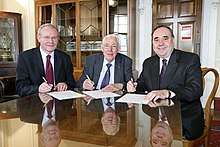
The new Articles 2 and 3, added to the Constitution to replace the earlier articles, implicitly acknowledge that the status of Northern Ireland, and its relationships within the rest of the United Kingdom and with the Republic of Ireland, would only be changed with the agreement of a majority of voters in each jurisdiction. This aspect was also central to the Belfast Agreement which was signed in 1998 and ratified by referendums held simultaneously in both Northern Ireland and the Republic. At the same time, the British Government recognised for the first time, as part of the prospective, the so-called "Irish dimension": the principle that the people of the island of Ireland as a whole have the right, without any outside interference, to solve the issues between North and South by mutual consent.[50] The latter statement was key to winning support for the agreement from nationalists. It established a devolved power-sharing government within Northern Ireland, which must consist of both unionist and nationalist parties. These institutions were suspended by the British Government in 2002 after Police Service of Northern Ireland (PSNI) allegations of spying by people working for Sinn Féin at the Assembly (Stormontgate). The resulting case against the accused Sinn Féin member collapsed.[51][52]
On 28 July 2005, the Provisional IRA declared an end to its campaign and has since decommissioned what is thought to be all of its arsenal. This final act of decommissioning was performed under the watch of the Independent International Commission on Decommissioning (IICD) and two external church witnesses. Many unionists, however, remained sceptical. The IICD later confirmed that the main loyalist paramilitary groups, the Ulster Defence Association, UVF and the Red Hand Commando, had decommissioned what is thought to be all of their arsenals, witnessed by former archbishop Robin Eames and a former top civil servant.[53]
Politicians elected to the Assembly at the 2003 Assembly election were called together on 15 May 2006 under the Northern Ireland Act 2006[54] for the purpose of electing a First Minister and deputy First Minister of Northern Ireland and choosing the members of an Executive (before 25 November 2006) as a preliminary step to the restoration of devolved government.
Following the election held on 7 March 2007, devolved government returned on 8 May 2007 with Democratic Unionist Party (DUP) leader Ian Paisley and Sinn Féin deputy leader Martin McGuinness taking office as First Minister and deputy First Minister, respectively.[55] In its white paper on Brexit the United Kingdom government reiterated its commitment to the Belfast Agreement. With regard to Northern Ireland's status, it said that the UK Government's "clearly-stated preference is to retain Northern Ireland’s current constitutional position: as part of the UK, but with strong links to Ireland".[56]
Politics
Background
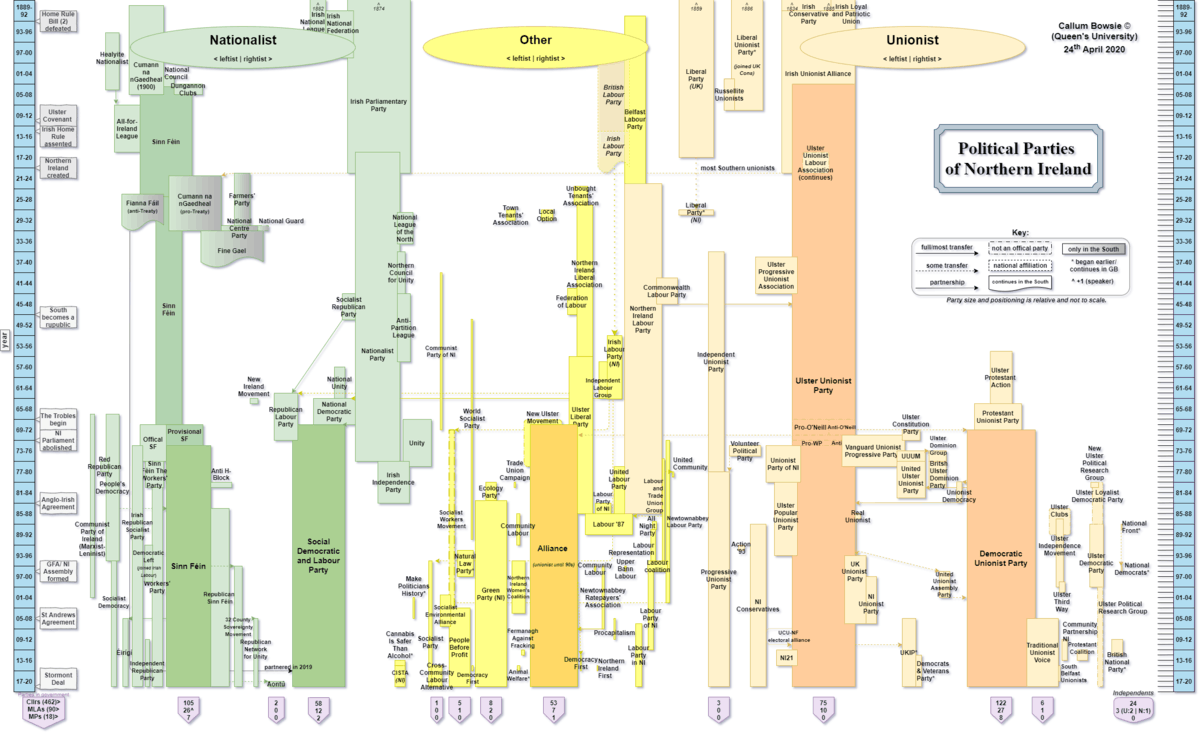
The main political divide in Northern Ireland is between unionists, who wish to see Northern Ireland continue as part of the United Kingdom, and nationalists, who wish to see Northern Ireland unified with the Republic of Ireland, independent from the United Kingdom. These two opposing views are linked to deeper cultural divisions. Unionists are predominantly Ulster Protestant, descendants of mainly Scottish, English, and Huguenot settlers as well as Gaels who converted to one of the Protestant denominations. Nationalists are overwhelmingly Catholic and descend from the population predating the settlement, with a minority from the Scottish Highlands as well as some converts from Protestantism. Discrimination against nationalists under the Stormont government (1921–1972) gave rise to the civil rights movement in the 1960s.[57]
While some unionists argue that discrimination was not just due to religious or political bigotry, but also the result of more complex socio-economic, socio-political and geographical factors,[58] its existence, and the manner in which nationalist anger at it was handled, were a major contributing factor to the Troubles. The political unrest went through its most violent phase between 1968 and 1994.[59]
In 2007, 36% of the population defined themselves as unionist, 24% as nationalist and 40% defined themselves as neither.[60] According to a 2015 opinion poll, 70% express a long-term preference of the maintenance of Northern Ireland's membership of the United Kingdom (either directly ruled or with devolved government), while 14% express a preference for membership of a united Ireland.[61] This discrepancy can be explained by the overwhelming preference among Protestants to remain a part of the UK (93%), while Catholic preferences are spread across a number of solutions to the constitutional question including remaining a part of the UK (47%), a united Ireland (32%), Northern Ireland becoming an independent state (4%), and those who "don't know" (16%).[62]
Official voting figures, which reflect views on the "national question" along with issues of candidate, geography, personal loyalty and historic voting patterns, show 54% of Northern Ireland voters vote for unionist parties, 42% vote for nationalist parties and 4% vote "other". Opinion polls consistently show that the election results are not necessarily an indication of the electorate's stance regarding the constitutional status of Northern Ireland. Most of the population of Northern Ireland are at least nominally Christian, mostly Roman Catholic and Protestant denominations. Many voters (regardless of religious affiliation) are attracted to unionism's conservative policies, while other voters are instead attracted to the traditionally leftist Sinn Féin and SDLP and their respective party platforms for democratic socialism and social democracy.[63]
For the most part, Protestants feel a strong connection with Great Britain and wish for Northern Ireland to remain part of the United Kingdom. Many Catholics however, generally aspire to a United Ireland or are less certain about how to solve the constitutional question. In the 2015 survey by Northern Ireland Life and Times, 47% of Northern Irish Catholics supported Northern Ireland remaining a part of the United Kingdom, either by direct rule (6%) or devolved government (41%).
Protestants have a slight majority in Northern Ireland, according to the latest Northern Ireland Census. The make-up of the Northern Ireland Assembly reflects the appeals of the various parties within the population. Of the 108 Members of the Legislative Assembly (MLAs), 56 are unionists and 40 are nationalists (the remaining 12 are classified as "other").
Governance
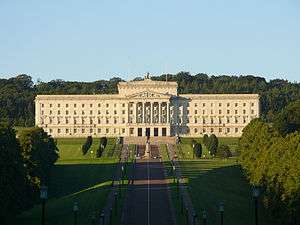
Since 1998, Northern Ireland has had devolved government within the United Kingdom, presided over by the Northern Ireland Assembly and a cross-community government (the Northern Ireland Executive). The UK Government and UK Parliament are responsible for reserved and excepted matters. Reserved matters comprise listed policy areas (such as civil aviation, units of measurement, and human genetics) that Parliament may devolve to the Assembly some time in the future. Excepted matters (such as international relations, taxation and elections) are never expected to be considered for devolution. On all other governmental matters, the Executive together with the 90-member Assembly may legislate for and govern Northern Ireland. Devolution in Northern Ireland is dependent upon participation by members of the Northern Ireland executive in the North/South Ministerial Council, which coordinates areas of co-operation (such as agriculture, education and health) between Northern Ireland and the Republic of Ireland. Additionally, "in recognition of the Irish Government's special interest in Northern Ireland", the Government of Ireland and Government of the United Kingdom co-operate closely on non-devolved matters through the British-Irish Intergovernmental Conference.
Elections to the Northern Ireland Assembly are by single transferable vote with five Members of the Legislative Assembly (MLAs) elected from each of 18 parliamentary constituencies. In addition, eighteen representatives (Members of Parliament, MPs) are elected to the lower house of the UK parliament from the same constituencies using the first-past-the-post system. However, not all of those elected take their seats. Sinn Féin MPs, currently seven, refuse to take the oath to serve the Queen that is required before MPs are allowed to take their seats. In addition, the upper house of the UK parliament, the House of Lords, currently has some 25 appointed members from Northern Ireland.
The Northern Ireland Office represents the UK government in Northern Ireland on reserved matters and represents Northern Ireland's interests within the UK Government. Additionally, the Republic's government also has the right to "put forward views and proposals" on non-devolved matters in relation to Northern Ireland. The Northern Ireland Office is led by the Secretary of State for Northern Ireland, who sits in the Cabinet of the United Kingdom.
Northern Ireland is a distinct legal jurisdiction, separate from the two other jurisdictions in the United Kingdom (England and Wales, and Scotland). Northern Ireland law developed from Irish law that existed before the partition of Ireland in 1921. Northern Ireland is a common law jurisdiction and its common law is similar to that in England and Wales. However, there are important differences in law and procedure between Northern Ireland and England and Wales. The body of statute law affecting Northern Ireland reflects the history of Northern Ireland, including Acts of the Parliament of the United Kingdom, the Northern Ireland Assembly, the former Parliament of Northern Ireland and the Parliament of Ireland, along with some Acts of the Parliament of England and of the Parliament of Great Britain that were extended to Ireland under Poynings' Law between 1494 and 1782.
Descriptions
There is no generally accepted term to describe what Northern Ireland is: province, region, country or something else.[11][12][13] The choice of term can be controversial and can reveal the writer's political preferences.[12] This has been noted as a problem by several writers on Northern Ireland, with no generally recommended solution.[11][12][13]
Owing in part to the way in which the United Kingdom, and Northern Ireland, came into being, there is no legally defined term to describe what Northern Ireland 'is'. There is also no uniform or guiding way to refer to Northern Ireland amongst the agencies of the UK government. For example, the websites of the Office of the Prime Minister of the United Kingdom[64] and the UK Statistics Authority describe the United Kingdom as being made up of four countries, one of these being Northern Ireland.[65] Other pages on the same websites refer to Northern Ireland specifically as a "province" as do publications of the UK Statistics Authority.[66][67] The website of the Northern Ireland Statistics and Research Agency also refers to Northern Ireland as being a province[68] as does the website of the Office of Public Sector Information[69] and other agencies within Northern Ireland.[70] Publications of HM Treasury[71] and the Department of Finance and Personnel of the Northern Ireland Executive,[72] on the other hand, describe Northern Ireland as being a "region of the UK". The UK's submission to the 2007 United Nations Conference on the Standardization of Geographical Names defines the UK as being made up of two countries (England and Scotland), one principality (Wales) and one province (Northern Ireland).[73]
Unlike England, Scotland and Wales, Northern Ireland has no history of being an independent country or of being a nation in its own right.[74] Some writers describe the United Kingdom as being made up of three countries and one province[75] or point out the difficulties with calling Northern Ireland a country.[76] Authors writing specifically about Northern Ireland dismiss the idea that Northern Ireland is a "country" in general terms,[11][13][77][78] and draw contrasts in this respect with England, Scotland and Wales.[79] Even for the period covering the first 50 years of Northern Ireland's existence, the term country is considered inappropriate by some political scientists on the basis that many decisions were still made in London.[74] The absence of a distinct nation of Northern Ireland, separate within the island of Ireland, is also pointed out as being a problem with using the term[13][80][81] and is in contrast to England, Scotland, and Wales.[82]
Many commentators prefer to use the term "province", although that is also not without problems. It can arouse irritation, particularly among nationalists, for whom the title province is properly reserved for the traditional province of Ulster, of which Northern Ireland comprises six out of nine counties.[12][76] The BBC style guide is to refer to Northern Ireland as a province, and use of the term is common in literature and newspaper reports on Northern Ireland and the United Kingdom. Some authors have described the meaning of this term as being equivocal: referring to Northern Ireland as being a province both of the United Kingdom and of the traditional country of Ireland.[80]
"Region" is used by several UK government agencies and the European Union. Some authors choose this word but note that it is "unsatisfactory".[12][13] Northern Ireland can also be simply described as "part of the UK", including by UK government offices.[64]
Alternative names
Many people inside and outside Northern Ireland use other names for Northern Ireland, depending on their point of view. Disagreement on names, and the reading of political symbolism into the use or non-use of a word, also attaches itself to some urban centres. The most notable example is whether Northern Ireland's second city should be called "Derry" or "Londonderry".
Choice of language and nomenclature in Northern Ireland often reveals the cultural, ethnic and religious identity of the speaker. Those who do not belong to any group but lean towards one side often tend to use the language of that group. Supporters of unionism in the British media (notably The Daily Telegraph and the Daily Express) regularly call Northern Ireland "Ulster".[83] Some media outlets in the Republic use "North of Ireland", "the North", or (less often) the "Six Counties".
Government and cultural organisations in Northern Ireland often use the word "Ulster" in their title; for example, the University of Ulster, the Ulster Museum, the Ulster Orchestra, and BBC Radio Ulster.
Although some news bulletins since the 1990s have opted to avoid all contentious terms and use the official name, Northern Ireland, the term "the North" remains commonly used by broadcast media in the Republic.
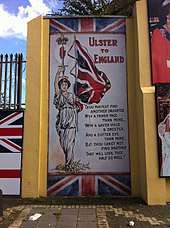
Unionist
- Ulster, strictly speaking, refers to the province of Ulster, of which six of nine historical counties are in Northern Ireland. The term "Ulster" is widely used by unionists and the British press as shorthand for Northern Ireland, and is also favoured by Ulster nationalists.[84] In the past, calls have been made for Northern Ireland's name to be changed to Ulster. This proposal was formally considered by the Government of Northern Ireland in 1937 and by the UK Government in 1949 but no change was made.[85]
- The Province refers to the historic Irish province of Ulster but today is used by some as shorthand for Northern Ireland. The BBC, in its editorial guidance for Reporting the United Kingdom, states that "the Province" is an appropriate secondary synonym for Northern Ireland, while "Ulster" is not. It also suggests that "people of Northern Ireland" is preferred to "British" or "Irish", and the term "mainland" should be avoided in reference to Great Britain in relation to Northern Ireland.[86]
Nationalist
- North of Ireland – used to avoid using the name given by the British-enacted Government of Ireland Act 1920.
- The Six Counties (na Sé Chontae) – the Republic of Ireland is similarly described as the Twenty-Six Counties.[87] Some of the users of these terms contend that using the official name of the region would imply acceptance of the legitimacy of the Government of Ireland Act.
- The Occupied Six Counties – used by some republicans.[88] The Republic, whose legitimacy is similarly not recognised by republicans opposed to the Belfast Agreement, is described as the "Free State", referring to the Irish Free State, which gained independence (as a Dominion) in 1922.[89]
- British-Occupied Ireland – Similar in tone to the Occupied Six Counties,[90] this term is used by more dogmatic republicans, such as Republican Sinn Féin,[91] who still hold that the Second Dáil was the last legitimate government of Ireland and that all governments since have been foreign-imposed usurpations of Irish national self-determination.[92]
Other
- Norn Iron or "Norniron" – is an informal and affectionate[93] local nickname used to refer to Northern Ireland, derived from the pronunciation of the words "Northern Ireland" in an exaggerated Ulster accent (particularly one from the greater Belfast area). The phrase is seen as a lighthearted way to refer to Northern Ireland, based as it is on regional pronunciation. It often refers to the Northern Ireland national football team.[94]
Geography and climate
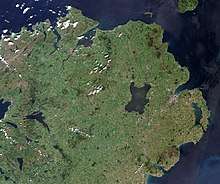
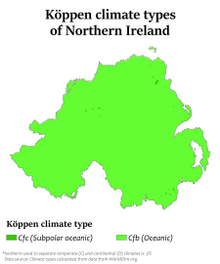
Northern Ireland was covered by an ice sheet for most of the last ice age and on numerous previous occasions, the legacy of which can be seen in the extensive coverage of drumlins in Counties Fermanagh, Armagh, Antrim and particularly Down.
The centrepiece of Northern Ireland's geography is Lough Neagh, at 151 square miles (391 km2) the largest freshwater lake both on the island of Ireland and in the British Isles. A second extensive lake system is centred on Lower and Upper Lough Erne in Fermanagh. The largest island of Northern Ireland is Rathlin, off the north Antrim coast. Strangford Lough is the largest inlet in the British Isles, covering 150 km2 (58 sq mi).
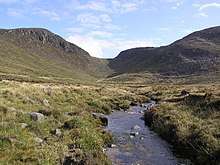
There are substantial uplands in the Sperrin Mountains (an extension of the Caledonian mountain belt) with extensive gold deposits, granite Mourne Mountains and basalt Antrim Plateau, as well as smaller ranges in South Armagh and along the Fermanagh–Tyrone border. None of the hills are especially high, with Slieve Donard in the dramatic Mournes reaching 850 metres (2,789 ft), Northern Ireland's highest point. Belfast's most prominent peak is Cavehill.
The volcanic activity which created the Antrim Plateau also formed the eerily geometric pillars of the Giant's Causeway on the north Antrim coast. Also in north Antrim are the Carrick-a-Rede Rope Bridge, Mussenden Temple and the Glens of Antrim.
The Lower and Upper River Bann, River Foyle and River Blackwater form extensive fertile lowlands, with excellent arable land also found in North and East Down, although much of the hill country is marginal and suitable largely for animal husbandry.
The valley of the River Lagan is dominated by Belfast, whose metropolitan area includes over a third of the population of Northern Ireland, with heavy urbanisation and industrialisation along the Lagan Valley and both shores of Belfast Lough.
The vast majority of Northern Ireland has a temperate maritime climate, (Cfb in the Koeppen climate classification) rather wetter in the west than the east, although cloud cover is very common across the region. The weather is unpredictable at all times of the year, and although the seasons are distinct, they are considerably less pronounced than in interior Europe or the eastern seaboard of North America. Average daytime maximums in Belfast are 6.5 °C (43.7 °F) in January and 17.5 °C (63.5 °F) in July. The highest maximum temperature recorded was 30.8 °C (87.4 °F) at Knockarevan, near Garrison, County Fermanagh on 30 June 1976 and at Belfast on 12 July 1983.[95] The lowest minimum temperature recorded was −18.7 °C (−1.7 °F) at Castlederg, County Tyrone on 23 December 2010.[96]
Northern Ireland is the least forested part of the United Kingdom and Ireland, and one of the least forested parts of Europe.[97][98] Until the end of the Middle Ages, the land was heavily forested with native trees such as oak, ash, hazel, birch, alder, willow, aspen, elm, rowan, yew and Scots pine.[99] Today, only 8% of Northern Ireland is woodland, and most of this is non-native conifer plantations.[100]
Counties
Northern Ireland consists of six historic counties: County Antrim, County Armagh, County Down, County Fermanagh, County Londonderry,[101] County Tyrone.
These counties are no longer used for local government purposes; instead, there are eleven districts of Northern Ireland which have different geographical extents. These were created in 2015, replacing the twenty-six districts which previously existed.[102]
Although counties are no longer used for local governmental purposes, they remain a popular means of describing where places are. They are officially used while applying for an Irish passport, which requires one to state one's county of birth. The name of that county then appears in both Irish and English on the passport's information page, as opposed to the town or city of birth on the United Kingdom passport. The Gaelic Athletic Association still uses the counties as its primary means of organisation and fields representative teams of each GAA county. The original system of car registration numbers largely based on counties still remains in use. In 2000, the telephone numbering system was restructured into an 8 digit scheme with (except for Belfast) the first digit approximately reflecting the county.
The county boundaries still appear on Ordnance Survey of Northern Ireland Maps and the Phillips Street Atlases, among others. With their decline in official use, there is often confusion surrounding towns and cities which lie near county boundaries, such as Belfast and Lisburn, which are split between counties Down and Antrim (the majorities of both cities, however, are in Antrim).
In March 2018, The Sunday Times published its list of Best Places to Live in Britain, including the following places in Northern Ireland: Ballyhackamore near Belfast (overall best for Northern Ireland), Holywood, County Down, Newcastle, County Down, Portrush, County Antrim, Strangford, County Down.[103]
Economy
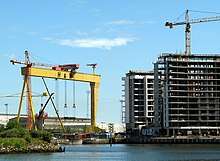
Northern Ireland has traditionally had an industrial economy, most notably in shipbuilding, rope manufacture and textiles, but most heavy industry has since been replaced by services, primarily the public sector.
Seventy percent of the economy's revenue comes from the service sector. Apart from the public sector, another important service sector is tourism, which rose to account for over 1% of the economy's revenue in 2004. Tourism has been a major growth area since the end of the Troubles. Key tourism attractions include the historic cities of Derry, Belfast and Armagh and the many castles in Northern Ireland. These large firms are attracted by government subsidies and the skilled workforce in Northern Ireland.
The local economy has seen contraction during the Great Recession. In response, the Northern Ireland Assembly has sent trade missions abroad. The Executive wishes to gain taxation powers from London, to align Northern Ireland's corporation tax rate with the unusually low rate of the Republic of Ireland.
Transport
Northern Ireland has underdeveloped transport infrastructure, with most infrastructure concentrated around Greater Belfast, Greater Derry and Craigavon. Northern Ireland is served by three airports – Belfast International near Antrim, George Best Belfast City integrated into the railway network at Sydenham in East Belfast, and City of Derry in County Londonderry.
Major seaports at Larne and Belfast carry passengers and freight between Great Britain and Northern Ireland.
Passenger railways are operated by Northern Ireland Railways. With Iarnród Éireann (Irish Rail), Northern Ireland Railways co-operates in providing the joint Enterprise service between Dublin Connolly and Lanyon Place. The whole of Ireland has a mainline railway network with a gauge of 5 ft 3 in (1,600 mm), which is unique in Europe and has resulted in distinct rolling stock designs. The only preserved line of this gauge is the Downpatrick and County Down Railway, which operates steam and diesel locomotives. Main railway lines linking to and from Belfast Great Victoria Street railway station and Lanyon Place railway station are:
- The Derry Line and the Portrush Branch.
- The Larne Line
- The Bangor Line
- The Portadown Line
Main motorways are:
- M1 connecting Belfast to the south and west, ending in Dungannon
- M12 connecting the M1 to Portadown
- M2 connecting Belfast to the north. An unconnected section of the M2 also by-passes Ballymena
- M22 connecting the M2 to near Randalstown
- M3 connecting the M1 (via the A12) and M2 in Belfast with the A2 dual carriageway to Bangor
- M5 connecting Belfast to Newtownabbey
The cross-border road connecting the ports of Larne in Northern Ireland and Rosslare Harbour in the Republic of Ireland is being upgraded as part of an EU-funded scheme. European route E01 runs from Larne through the island of Ireland, Spain and Portugal to Seville.
Demographics
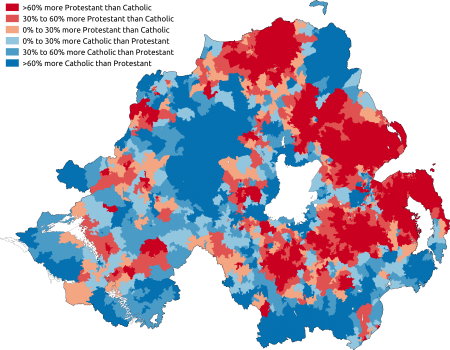
The population of Northern Ireland has risen yearly since 1978. The population in 2011 was 1.8 million, having grown 7.5% over the previous decade[104] from just under 1.7 million in 2001. This constitutes just under 3% of the population of the UK (62 million) and just over 28% of the population of the island of Ireland (6.3 million).
The population of Northern Ireland is almost entirely white (98.2%).[104] In 2011, 88.8% of the population were born in Northern Ireland, with 4.5% born elsewhere in Britain, and 2.9% born in the Republic of Ireland. 4.3% were born elsewhere; triple the amount there were in 2001.[105] Most are from Eastern Europe and Lithuania and Latvia. The largest non-white ethnic groups were Chinese (6,300) and Indian (6,200). Black people of various origins made up 0.2% of the 2011 population and people of mixed ethnicity made up 0.2%.[106]
Religion
At the 2011 census, 41.5% of the population identified as Protestant/non-Roman Catholic Christian, 41% as Roman Catholic, and 0.8% as non-Christian, while 17% identified with no religion or did not state one.[106] The biggest of the Protestant/non-Roman Catholic Christian denominations were the Presbyterian Church (19%), the Church of Ireland (14%) and the Methodist Church (3%). In terms of community background (i.e. religion or religion brought up in), 48% of the population came from a Protestant background, 45% from a Catholic background, 0.9% from non-Christian backgrounds, and 5.6% from non-religious backgrounds.[106]
Cities
| Cities and towns by population[107] | ||||||
|---|---|---|---|---|---|---|
| # | Settlement | Population | Metro population |
|||
| 1 | Belfast | 334,420 | 671,559 | |||
| 2 | Derry | 84,750 | 237,000 | |||
| 3 | Lisburn [108] | 71,403 | ||||
| 4 | Greater Craigavon | 68,890 | ||||
| 5 | Newtownabbey [108] | 66,120 | ||||
| 6 | Bangor [108] | 62,650 | ||||
| 7 | Ballymena | 30,590 | ||||
| 8 | Newtownards | 28,860 | ||||
| 9 | Newry | 28,080 | ||||
| 10 | Carrickfergus [108] | 27,640 | ||||
Citizenship and identity
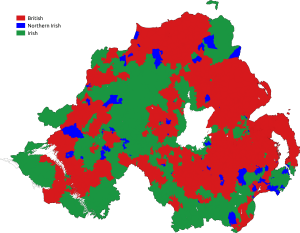
In the 2011 census in Northern Ireland respondents gave their national identity as follows.[109]
| National identity |
All | Religious affiliation | |||
|---|---|---|---|---|---|
| Catholic | Protestant and other Christian | Non- Christian | None | ||
| British | 48.4% | 12.9% | 81.6% | 50.1% | 55.9% |
| Irish | 28.4% | 57.2% | 3.9% | 12.4% | 14.0% |
| Northern Irish | 29.4% | 30.7% | 26.9% | 18.0% | 35.2% |
| English, Scottish, or Welsh | 1.6% | 0.8% | 1.5% | 2.9% | 5.2% |
| All other | 3.4% | 4.4% | 1.0% | 29.1% | 7.1% |
Several studies and surveys carried out between 1971 and 2006 have indicated that, in general, most Protestants in Northern Ireland see themselves primarily as British, whereas a majority of Roman Catholics regard themselves primarily as Irish.[110][111][112][113][114][115][116][117] This does not, however, account for the complex identities within Northern Ireland, given that many of the population regard themselves as "Ulster" or "Northern Irish", either as a primary or secondary identity. Overall, the Catholic population is somewhat more ethnically diverse than the more homogeneous Protestant population. 83.1% of Protestants identified as "British" or with a British ethnic group (English, Scottish, or Welsh) in the 2011 Census, whereas only 3.9% identified as "Irish". Meanwhile, 13.7% of Catholics identified as "British" or with a British ethnic group. A further 4.4% identified as "all other", which are largely immigrants, for example from Poland.
A 2008 survey found that 57% of Protestants described themselves as British, while 32% identified as Northern Irish, 6% as Ulster and 4% as Irish. Compared to a similar survey carried out in 1998, this shows a fall in the percentage of Protestants identifying as British and Ulster and a rise in those identifying as Northern Irish. The 2008 survey found that 61% of Catholics described themselves as Irish, with 25% identifying as Northern Irish, 8% as British and 1% as Ulster. These figures were largely unchanged from the 1998 results.[118][119]
People born in Northern Ireland are, with some exceptions, deemed by UK law to be citizens of the United Kingdom. They are also, with similar exceptions, entitled to be citizens of Ireland. This entitlement was reaffirmed in the 1998 Good Friday Agreement between the British and Irish governments, which provides that:
...it is the birthright of all the people of Northern Ireland to identify themselves and be accepted as Irish or British, or both, as they may so choose, and accordingly [the two governments] confirm that their right to hold both British and Irish citizenship is accepted by both Governments and would not be affected by any future change in the status of Northern Ireland.
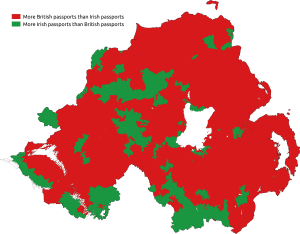
As a result of the Agreement, the Constitution of the Republic of Ireland was amended. The current wording provides that people born in Northern Ireland are entitled to be Irish citizens on the same basis as people from any other part of the island.[120]
Neither government, however, extends its citizenship to all persons born in Northern Ireland. Both governments exclude some people born in Northern Ireland, in particular persons born without one parent who is a British or Irish citizen. The Irish restriction was given effect by the twenty-seventh amendment to the Irish Constitution in 2004. The position in UK nationality law is that most of those born in Northern Ireland are UK nationals, whether or not they so choose. Renunciation of British citizenship requires the payment of a fee, currently £372.[121]
In the 2011 census in Northern Ireland respondents stated that they held the following passports.[122]
| Passport | All usual residents |
Religion or religion brought up in | |||
|---|---|---|---|---|---|
| Catholic | Protestant and other Christian | Other Religions | None | ||
| No passport | 18.9% | 19.2% | 18.5% | 9.9% | 20.2% |
| United Kingdom | 59.1% | 38.4% | 77.8% | 56.0% | 65.2% |
| Ireland | 20.8% | 40.5% | 4.1% | 10.0% | 7.2% |
| Other | 3.4% | 4.5% | 1.1% | 29.2% | 9.4% |
Languages
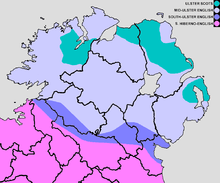
English is spoken as a first language by almost all of the Northern Ireland population. It is the de facto official language and the Administration of Justice (Language) Act (Ireland) 1737 prohibits the use of languages other than English in legal proceedings.
Under the Good Friday Agreement, Irish and Ulster Scots (an Ulster dialect of the Scots language, sometimes known as Ullans), are recognised as "part of the cultural wealth of Northern Ireland".[123] Two all-island bodies for the promotion of these were created under the Agreement: Foras na Gaeilge, which promotes the Irish language, and the Ulster Scots Agency, which promotes the Ulster Scots dialect and culture. These operate separately under the aegis of the North/South Language Body, which reports to the North/South Ministerial Council.
The British government in 2001 ratified the European Charter for Regional or Minority Languages. Irish (in Northern Ireland) was specified under Part III of the Charter, with a range of specific undertakings in relation to education, translation of statutes, interaction with public authorities, the use of placenames, media access, support for cultural activities and other matters. A lower level of recognition was accorded to Ulster Scots, under Part II of the Charter.[124]
English
The dialect of English spoken in Northern Ireland shows influence from the lowland Scots language.[125] There are supposedly some minute differences in pronunciation between Protestants and Catholics, for instance; the name of the letter h, which Protestants tend to pronounce as "aitch", as in British English, and Catholics tend to pronounce as "haitch", as in Hiberno-English. However, geography is a much more important determinant of dialect than religious background.
Irish
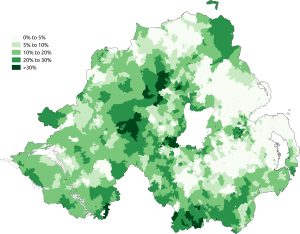
The Irish language (Irish: an Ghaeilge), or Gaelic, is a native language of Ireland.[126] It was spoken predominantly throughout what is now Northern Ireland before the Ulster Plantations in the 17th century and most place names in Northern Ireland are anglicised versions of a Gaelic name. Today, the language is often associated with Irish nationalism (and thus with Catholics). However, in the 19th century, the language was seen as a common heritage, with Ulster Protestants playing a leading role in the Gaelic revival.[127]
In the 2011 census, 11% of the population of Northern Ireland claimed "some knowledge of Irish"[104] and 3.7% reported being able to "speak, read, write and understand" Irish.[104] In another survey, from 1999, 1% of respondents said they spoke it as their main language at home.[128]
The dialect spoken in Northern Ireland, Ulster Irish, has two main types, East Ulster Irish and Donegal Irish (or West Ulster Irish),[129] is the one closest to Scottish Gaelic (which developed into a separate language from Irish Gaelic in the 17th century). Some words and phrases are shared with Scots Gaelic, and the dialects of east Ulster – those of Rathlin Island and the Glens of Antrim – were very similar to the dialect of Argyll, the part of Scotland nearest to Ireland. And those dialects of Armagh and Down were also very similar to the dialects of Galloway.
Use of the Irish language in Northern Ireland today is politically sensitive. The erection by some district councils of bilingual street names in both English and Irish,[130] invariably in predominantly nationalist districts, is resisted by unionists who claim that it creates a "chill factor" and thus harms community relationships. Efforts by members of the Northern Ireland Assembly to legislate for some official uses of the language have failed to achieve the required cross-community support, and the UK government has declined to legislate. There has recently been an increase in interest in the language among unionists in East Belfast.[131]
Ulster Scots
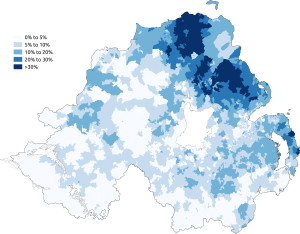
Ulster Scots comprises varieties of the Scots language spoken in Northern Ireland. For a native English speaker, "[Ulster Scots] is comparatively accessible, and even at its most intense can be understood fairly easily with the help of a glossary."[132]
Along with the Irish language, the Good Friday Agreement recognised the dialect as part of Northern Ireland's unique culture and the St Andrews Agreement recognised the need to "enhance and develop the Ulster Scots language, heritage and culture".[133]
Approximately 2% of the population claim to speak Ulster Scots.[134] However, the number speaking it as their main language in their home is negligible,[128] with only 0.9% of 2011 census respondents claiming to be able to speak, read, write and understand Ulster-Scots. 8.1% professed to have "some ability" however.[104]
Sign languages
The most common sign language in Northern Ireland is Northern Ireland Sign Language (NISL). However, because in the past Catholic families tended to send their deaf children to schools in Dublin where Irish Sign Language (ISL) is commonly used, ISL is still common among many older deaf people from Catholic families.
Irish Sign Language (ISL) has some influence from the French family of sign language, which includes American Sign Language (ASL). NISL takes a large component from the British family of sign language (which also includes Auslan) with many borrowings from ASL. It is described as being related to Irish Sign Language at the syntactic level while much of the lexicon is based on British Sign Language (BSL).[135]
As of March 2004 the British Government recognises only British Sign Language and Irish Sign Language as the official sign languages used in Northern Ireland.[136][137]
Culture
Northern Ireland shares both the culture of Ireland and the culture of the United Kingdom.
Parades are a prominent feature of Northern Ireland society,[138] more so than in the rest of Ireland or in Britain. Most are held by Protestant fraternities such as the Orange Order, and Ulster loyalist marching bands. Each summer, during the "marching season", these groups have hundreds of parades, deck streets with British flags, bunting and specially-made arches, and light large towering bonfires.[139] The biggest parades are held on 12 July (The Twelfth). There is often tension when these activities take place near Catholic neighbourhoods, which sometimes leads to violence.[140]
Since the end of the Troubles, Northern Ireland has witnessed rising numbers of tourists. Attractions include cultural festivals, musical and artistic traditions, countryside and geographical sites of interest, public houses, welcoming hospitality and sports (especially golf and fishing). Since 1987 public houses have been allowed to open on Sundays, despite some opposition.
The Ulster Cycle is a large body of prose and verse centring on the traditional heroes of the Ulaid in what is now eastern Ulster. This is one of the four major cycles of Irish mythology. The cycle centres on the reign of Conchobar mac Nessa, who is said to have been king of Ulster around the 1st century. He ruled from Emain Macha (now Navan Fort near Armagh), and had a fierce rivalry with queen Medb and king Ailill of Connacht and their ally, Fergus mac Róich, former king of Ulster. The foremost hero of the cycle is Conchobar's nephew Cúchulainn, who features in the epic prose/poem An Táin Bó Cúailnge (The Cattle Raid of Cooley, a cassus belli between Ulster and Connaught).
Symbols
Northern Ireland comprises a patchwork of communities whose national loyalties are represented in some areas by flags flown from flagpoles or lamp posts. The Union Jack and the former Northern Ireland flag are flown in many loyalist areas, and the Tricolour, adopted by republicans as the flag of Ireland in 1916,[142] is flown in some republican areas. Even kerbstones in some areas are painted red-white-blue or green-white-orange, depending on whether local people express unionist/loyalist or nationalist/republican sympathies.[143]
The official flag is that of the state having sovereignty over the territory, i.e. the Union Flag.[144] The former Northern Ireland flag, also known as the "Ulster Banner" or "Red Hand Flag", is a banner derived from the coat of arms of the Government of Northern Ireland until 1972. Since 1972, it has had no official status. The Union Flag and the Ulster Banner are used exclusively by unionists. UK flags policy states that in Northern Ireland, "The Ulster flag and the Cross of St Patrick have no official status and, under the Flags Regulations, are not permitted to be flown from Government Buildings."[145][146]
The Irish Rugby Football Union and the Church of Ireland have used the Saint Patrick's Saltire or "Cross of St Patrick". This red saltire on a white field was used to represent Ireland in the flag of the United Kingdom. It is still used by some British army regiments. Foreign flags are also found, such as the Palestinian flags in some nationalist areas and Israeli flags in some unionist areas.[147]
The United Kingdom national anthem of "God Save the Queen" is often played at state events in Northern Ireland. At the Commonwealth Games and some other sporting events, the Northern Ireland team uses the Ulster Banner as its flag—notwithstanding its lack of official status—and the Londonderry Air (usually set to lyrics as Danny Boy), which also has no official status, as its national anthem.[148][149] The national football team also uses the Ulster Banner as its flag but uses "God Save The Queen" as its anthem.[150] Major Gaelic Athletic Association matches are opened by the national anthem of the Republic of Ireland, "Amhrán na bhFiann (The Soldier's Song)", which is also used by most other all-Ireland sporting organisations.[151] Since 1995, the Ireland rugby union team has used a specially commissioned song, "Ireland's Call" as the team's anthem. The Irish national anthem is also played at Dublin home matches, being the anthem of the host country.[152]
Northern Irish murals have become well-known features of Northern Ireland, depicting past and present events and documenting peace and cultural diversity. Almost 2,000 murals have been documented in Northern Ireland since the 1970s.
Sport
In Northern Ireland, sport is popular and important in the lives of many people. Sports tend to be organised on an all-Ireland basis, with a single team for the whole island.[153] The most notable exception is association football, which has separate governing bodies for each jurisdiction.[153]
Field sports
Association football

The Irish Football Association (IFA) serves as the organising body for association football in Northern Ireland, with the Northern Ireland Football League (NIFL) responsible for the independent administration of the three divisions of national domestic football, as well as the Northern Ireland Football League Cup.
The highest level of competition within Northern Ireland are the NIFL Premiership and the NIFL Championship. However, many players from Northern Ireland compete with clubs in England and Scotland.
NIFL clubs are semi-professional or Intermediate.NIFL Premiership clubs are also eligible to compete in the UEFA Champions League and UEFA Europa League with the league champions entering the Champions league second qualifying round and the 2nd placed league finisher, the European play-off winners and the Irish Cup winners entering the Europa League second qualifying round. No clubs have ever reached the group stage.
Despite Northern Ireland's small population, the national team qualified for the World Cup in 1958, 1982 and 1986, making it to the quarter-finals in 1958 and 1982 and made it the first knockout round in the European Championships in 2016.
Rugby union
The six counties of Northern Ireland are among the nine governed by the Ulster branch of the Irish Rugby Football Union, the governing body of rugby union in Ireland. Ulster is one of the four professional provincial teams in Ireland and competes in the Pro14 and European Cup. It won the European Cup in 1999.
In international competitions, the Ireland national rugby union team's recent successes include four Triple Crowns between 2004 and 2009 and a Grand Slam in 2009 in the Six Nations Championship.
Cricket
Northern Ireland plays as the Ireland cricket team which represents both Northern Ireland and Republic of Ireland. The Ireland Cricket team is a full member of the International Cricket Council, having been granted Test status and full membership (along with Afghanistan) by the ICC in June 2017. They are currently able to compete in Test cricket, the highest level of competitive cricket in the international arena and they are one of the twelve full-member countries under the ICC.
Ireland is the current champion of the ICC Intercontinental Cup. One of Ireland's regular international venues is Stormont in Belfast.
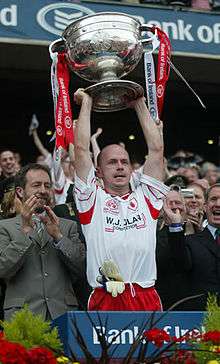
Gaelic games
Gaelic games include Gaelic football, hurling (and camogie), handball and rounders. Of the four, football is the most popular in Northern Ireland. Players play for local clubs with the best being selected for their county teams. The Ulster GAA is the branch of the Gaelic Athletic Association that is responsible for the nine counties of Ulster, which include the six of Northern Ireland.
These nine county teams participate in the Ulster Senior Football Championship, Ulster Senior Hurling Championship, All-Ireland Senior Football Championship and All-Ireland Senior Hurling Championship.
Recent successes for Northern Ireland teams include Armagh's 2002 All-Ireland Senior Football Championship win and Tyrone's wins in 2003, 2005 and 2008.
Golf
.jpg)
Perhaps Northern Ireland's most notable successes in professional sport have come in golf. Northern Ireland has contributed more major champions in the modern era than any other European country, with three in the space of just 14 months from the U.S. Open in 2010 to The Open Championship in 2011. Notable golfers include Fred Daly (winner of The Open in 1947), Ryder Cup players Ronan Rafferty and David Feherty, leading European Tour professionals David Jones, Michael Hoey (a five-time winner on the tour) and Gareth Maybin, as well as three recent major winners Graeme McDowell (winner of the U.S. Open in 2010, the first European to do so since 1970), Rory McIlroy (winner of four majors) and Darren Clarke (winner of The Open in 2011).[154][155] Northern Ireland has also contributed several players to the Great Britain and Ireland Walker Cup team, including Alan Dunbar and Paul Cutler who played on the victorious 2011 team in Scotland. Dunbar also won The Amateur Championship in 2012, at Royal Troon.
The Golfing Union of Ireland, the governing body for men's and boy's amateur golf throughout Ireland and the oldest golfing union in the world, was founded in Belfast in 1891. Northern Ireland's golf courses include the Royal Belfast Golf Club (the earliest, formed in 1881), Royal Portrush Golf Club, which is the only course outside Great Britain to have hosted The Open Championship, and Royal County Down Golf Club (Golf Digest magazine's top-rated course outside the United States).[156][157]
Snooker
Northern Ireland has produced two world snooker champions; Alex Higgins, who won the title in 1972 and 1982, and Dennis Taylor, who won in 1985. The highest-ranked Northern Ireland professional on the world circuit presently is Mark Allen from Antrim. The sport is governed locally by the Northern Ireland Billiards and Snooker Association who run regular ranking tournaments and competitions.
Motorsport
Motorcycle racing
Motorcycle racing is a particularly popular sport during the summer months, with the main meetings of the season attracting some of the largest crowds to any outdoor sporting event in the whole of Ireland.[158] Two of the three major international road race meetings are held in Northern Ireland, these being the North West 200[159] and the Ulster Grand Prix. In addition racing on purpose built circuits take place at Kirkistown and Bishop's Court,[160] whilst smaller road race meetings are held such as the Cookstown 100, the Armoy Road Races[161] and the Tandragee 100[162] all of which form part of the Irish National Road Race Championships[163] and which have produced some of the greatest motorcycle racers in the history of the sport, notably Joey Dunlop.
Motor racing
Although Northern Ireland lacks an international automobile racecourse, two Northern Irish drivers have finished inside the top two of Formula One, with John Watson achieving the feat in 1982 and Eddie Irvine doing the same in 1999. The largest course and the only MSA-licensed track for UK-wide competition is Kirkistown.[164]
Rugby league
The Ireland national rugby league team has participated in the Emerging Nations Tournament (1995), the Super League World Nines (1996), the World Cup (2000 and 2008), European Nations Cup (since 2003) and Victory Cup (2004).
The Ireland A rugby league team compete annually in the Amateur Four Nations competition (since 2002) and the St Patrick's Day Challenge (since 1995).
Ice hockey
The Belfast Giants have competed in the Elite Ice Hockey League since the 2000-01 season and are the sole Northern Irish team in the league. The team's roster has featured Northern Irish born players such as Mark Morrison, Graeme Walton and Gareth Roberts among others.[165]
Geraldine Heaney, an Olympic gold medalist and one of the first women inducted into the IIHF Hall of Fame, competed internationally for Canada but was born in Northern Ireland.[166]
Owen Nolan, (born 12 February 1972) is a Canadian former professional ice hockey player born in Northern Ireland. He was drafted 1st overall in the 1990 NHL Draft by the Quebec Nordiques. [167]
Professional wrestling
In 2007, after the closure of UCW (Ulster Championship Wrestling) which was a wrestling promotion, PWU formed, standing for Pro Wrestling Ulster. The wrestling promotion features championships, former WWE superstars and local independent wrestlers. Events and IPPV's throughout Northern Ireland.[168]
Education
Unlike most areas of the United Kingdom, in the last year of primary school, many children sit entrance examinations for grammar schools.
Integrated schools, which attempt to ensure a balance in enrolment between pupils of Protestant, Roman Catholic and other faiths (or none), are becoming increasingly popular, although Northern Ireland still has a primarily de facto religiously segregated education system. In the primary school sector, 40 schools (8.9% of the total number) are integrated schools and 32 (7.2% of the total number) are Irish language-medium schools.
The main universities in Northern Ireland are Queen's University Belfast and Ulster University, and the distance learning Open University which has a regional office in Belfast.
Wildlife
356 species of marine algae have been recorded in the north-east of Ireland. As Counties Londonderry, Antrim and Down are the only three counties of Northern Ireland with a shoreline this will apply to all Northern Ireland. 77 species are considered rare having been recorded rarely.[169]
Media and communications
The BBC has a division called BBC Northern Ireland with headquarters in Belfast. As well as broadcasting standard UK-wide programmes, BBC NI produces local content, including a news break-out called BBC Newsline. The ITV franchise in Northern Ireland is Ulster Television (UTV). The state-owned Channel 4 and the privately owned Channel 5 also broadcast in Northern Ireland. Access is available to satellite and cable services.[170] All Northern Ireland viewers must obtain a UK TV licence to watch live television transmissions.
RTÉ, the national broadcaster of the Republic of Ireland, is available over the air to most parts of Northern Ireland via reception overspill[171] and via satellite and cable. Since the digital TV switchover, RTÉ One, RTÉ2 and the Irish-language channel TG4, are now available over the air on the UK's Freeview system from transmitters within Northern Ireland.[172] Although they are transmitted in standard definition, a Freeview HD box or television is required for reception.
As well as the standard UK-wide radio stations from the BBC, Northern Ireland is home to many local radio stations, such as Cool FM, CityBeat, and Q102.9. The BBC has two regional radio stations which broadcast in Northern Ireland, BBC Radio Ulster and BBC Radio Foyle.
Besides the UK and Irish national newspapers, there are three main regional newspapers published in Northern Ireland. These are the Belfast Telegraph, the Irish News and the News Letter.[173] According to the Audit Bureau of Circulations (UK) the average daily circulation for these three titles in 2018 was:
Title Market type Print time Political alignment Format Circulation Jan-Jun 2018[174] Circulation Jul-Dec 2018[175] The Belfast Telegraph Regional Morning Non-Sectarianism/British Unionism Compact 35,931 33,951 The Irish News Regional Morning Irish nationalism Compact 33,647 32,315 The News Letter Regional Morning British unionism Tabloid 13,374 12,499
Northern Ireland uses the same telecommunications and postal services as the rest of the United Kingdom at standard domestic rates and there are no mobile roaming charges between Great Britain and Northern Ireland.[176][177] People in Northern Ireland who live close to the border with the Republic of Ireland may inadvertently switch over to the Irish mobile networks, causing international roaming fees to be applied.[178] Calls from landlines in Northern Ireland to numbers in the Republic of Ireland are charged at the same rate as those to numbers in Great Britain, while landline numbers in Northern Ireland can similarly be called from the Republic of Ireland at domestic rates, using the 048 prefix.[179]
References
- "Northern Ireland Census 2011 Output" (PDF). Northern Ireland Statistics and Research Agency. 11 December 2012. p. 15. Retrieved 7 October 2019.
- "The Countries of the UK". Office for National Statistics. Office for National Statistics (United Kingdom). Retrieved 7 July 2015.
- "Population estimates – Office for National Statistics". www.ons.gov.uk. Retrieved 18 July 2020.
- Northern Ireland Statistics & Research Agency (December 2012). "Census 2011 Key Statistics for Northern Ireland" (PDF). Archived from the original (PDF) on 24 December 2012. Retrieved 14 January 2013.
- https://www.ons.gov.uk/economy/grossdomesticproductgdp/bulletins/regionaleconomicactivitybygrossdomesticproductuk/1998to2018/pdf
- "Sub-national HDI - Area Database - Global Data Lab". hdi.globaldatalab.org. Retrieved 13 September 2018.
- "The Flags Regulations (Northern Ireland) 2000". Government of the United Kingdom. 8 November 2000. Retrieved 26 October 2019.
- Tuaisceart Éireann. DFA.ie. Retrieved 27 March 2016.
- "Statistic of the United Kingdom". Archived from the original on 5 January 2016.
- "Northern Ireland". Encyclopædia Britannica. Retrieved 11 October 2015.
- S. Dunn; H. Dawson (2000), An Alphabetical Listing of Word, Name and Place in Northern Ireland and the Living Language of Conflict, Lampeter: Edwin Mellen Press,
One specific problem – in both general and particular senses – is to know what to call Northern Ireland itself: in the general sense, it is not a country, or a province, or a state – although some refer to it contemptuously as a statelet: the least controversial word appears to be jurisdiction, but this might change.
- J. Whyte; G. FitzGerald (1991), Interpreting Northern Ireland, Oxford: Oxford University Press,
One problem must be adverted to in writing about Northern Ireland. This is the question of what name to give to the various geographical entities. These names can be controversial, with the choice often revealing one's political preferences. ... some refer to Northern Ireland as a 'province'. That usage can arouse irritation particularly among nationalists, who claim the title 'province' should be properly reserved to the four historic provinces of Ireland-Ulster, Leinster, Munster, and Connacht. If I want to a label to apply to Northern Ireland I shall call it a 'region'. Unionists should find that title as acceptable as 'province': Northern Ireland appears as a region in the regional statistics of the United Kingdom published by the British government.
- D. Murphy (1979), A Place Apart, London: Penguin Books,
Next – what noun is appropriate to Northern Ireland? 'Province' won't do since one-third of the province is on the wrong side of the border. 'State' implies more self-determination than Northern Ireland has ever had and 'country' or 'nation' are blatantly absurd. 'Colony' has overtones that would be resented by both communities and 'statelet' sounds too patronizing, though outsiders might consider it more precise than anything else; so one is left with the unsatisfactory word 'region'.
- Government of the United Kingdom of Great Britain and Northern Ireland; Government of Ireland (1998), Northern Ireland Peace Agreement (The Good Friday Agreement)
- Northern Ireland has a government again after 3 years BY JILL LAWLESS, THE ASSOCIATED PRESS/Global News, 11 January 2020
- "Standing up for Northern Ireland". Ulster Unionist Party. Archived from the original on 4 May 2009. Retrieved 2 August 2008.
- Richard Jenkin, 1997, Rethinking ethnicity: arguments and explorations, SAGE Publications: London: "In Northern Ireland the objectives of contemporary nationalists are the reunification of Ireland and the removal of British government."
- Peter Dorey, 1995, British politics since 1945, Blackwell Publishers: Oxford: "Just as some Nationalists have been prepared to use violence in order to secure Irish reunification, so some Unionists have been prepared to use violence in order to oppose it."
- "Strategy Framework Document: Reunification through Planned Integration: Sinn Féin's All Ireland Agenda". Archived from the original on 16 July 2006. Sinn Féin. Retrieved 2 August 2008.
- "Policy Summaries: Constitutional Issues". Social Democratic and Labour Party. Archived from the original on 18 June 2009. Retrieved 2 August 2008.
- "Which of these best describes the way you think of yourself?". Northern Ireland Life and Times Survey. 2014. Retrieved 24 March 2016.
- David, Trimble. "Nobel Lecture". The Nobel Prize. Retrieved 8 August 2020.
- "CAIN: Sutton Index of Deaths".
- "CAIN: Northern Ireland Society – Security and Defence".
- "The troubles were over, but the killing continued. Some of the heirs to Ireland's violent traditions refused to give up their inheritance."Jack Holland: Hope against History: The Course of Conflict in Northern Ireland. Henry Holt & Company, 1999, p. 221; ISBN 0-8050-6087-1
- McCourt, Malachy (2004). History of Ireland. New York: MJF Books, Fine Communications. p. 324. ISBN 978-1-60671-037-1.
- Department of Enterprise, Trade, and Investment: Full Economic Overview, 15 October 2014 Archived 7 November 2014 at the Wayback Machine
- Larry Elliott. "UK unemployment rate falls to lowest level since 2008 financial crisis". The Guardian.
- "Bank holidays". Archived from the original on 22 November 2010.
- "Lundy's Day: Thousands attend 'peaceful' Londonderry parade". BBC News.
- Thernstrom, Stephan (1980). Harvard encyclopedia of American ethnic groups. Harvard University Press. p. 896. ISBN 978-0-674-37512-3. Retrieved 29 October 2011.
- "Born Fighting: How the Scots-Irish Shaped America". Powells.com. 12 August 2009. Retrieved 30 April 2010.
- Gwynn, Stephen (2009) [1923]. "The birth of the Irish Free State". The History of Ireland. Macmillan. ISBN 978-1-113-15514-6.
- Pilkington, Colin (2002). Devolution in Britain Today. Manchester University Press. p. 75. ISBN 978-0-7190-6076-2.
- Northern Ireland became a distinct region of the United Kingdom, by Order in Council on 3 May 1921 (Statutory Rules & Orders published by authority (SR&O) 1921, No. 533). Its constitutional roots remain the Act of Union, two complementary Acts, one passed by the Parliament of Great Britain, the other by the pre-1801 Parliament of Ireland.
- Martin, Ged (1999). "The Origins of Partition". In Anderson, Malcolm; Bort, Eberhard (eds.). The Irish Border: History, Politics, Culture. Liverpool University Press. p. 68. ISBN 978-0853239512. Retrieved 19 October 2015.
- Gibbons, Ivan (2015). The British Labour Party and the Establishment of the Irish Free State, 1918–1924. Palgrave Macmillan. p. 107. ISBN 978-1137444080. Retrieved 19 October 2015.
- "The Stormont Papers – View Volumes". Archived from the original on 15 April 2016. Retrieved 28 January 2008.
- "Anglo-Irish Treaty, sections 11, 12". Nationalarchives.ie. 6 December 1921. Retrieved 7 August 2013.
- "Anglo-Irish Relations, 1939–41: A Study in Multilateral Diplomacy and Military Restraint" in Twentieth Century British History (Oxford Journals, 2005), ISSN 1477-4674
- Malcolm Sutton's book, "Bear in Mind These Dead: An Index of Deaths from the Conflict in Ireland 1969–1993.
- "BBC – History – The Troubles – Violence".
- "CAIN: Northern Ireland Society – Security and Defence".
- "The Cameron Report – Disturbances in Northern Ireland (1969)". cain.ulst.ac.uk. Retrieved 29 October 2011.
- History of sectarianism in NI Archived 1 February 2014 at the Wayback Machine, gale.cengage.com; accessed 27 May 2015.
- Richard English, "The Interplay of Non-violent and Violent Action in Northern Ireland, 1967–72", in Adam Roberts and Timothy Garton Ash (eds.), Civil Resistance and Power Politics: The Experience of Non-violent Action from Gandhi to the Present, Oxford University Press, 2009; ISBN 978-0-19-955201-6, pp. 75–90.
- The Ballast report Archived 25 June 2008 at the Wayback Machine: "...the Police Ombudsman has concluded that this was collusion by certain police officers with identified UVF informants."
- "1973: Northern Ireland votes for union". BBC News. 9 March 1973. Retrieved 20 May 2010.
- "BBC News | NORTHERN IRELAND | Republic drops claim to NI". news.bbc.co.uk. Retrieved 23 July 2018.
- Parliamentary debate: "The British government agree that it is for the people of the island of Ireland alone, by agreement between the two parts respectively, to exercise their right of self-determination on the basis of consent, freely and concurrently given, North and South, to bring about a united Ireland, if that is their wish."
- "Securocrat sabotage exposed".
- McKay, Susan (2 April 2009). Bear in Mind These Dead. ISBN 9780571252183.
- "UDA confirm guns decommissioned" BBC news; retrieved 29 January 2014
- "Northern Ireland Act 2006 (c. 17)". Opsi.gov.uk. Retrieved 16 June 2010.
- (BBC)
- HM Government The United Kingdom's exit from and new partnership with the European Union; Cm 9417, February 2017
- "Professor John H. Whyte paper on discrimination in Northern Ireland". Cain.ulst.ac.uk. Retrieved 16 June 2010.
- "CAIN website key issues discrimination summary". Cain.ulst.ac.uk. 5 October 1968. Retrieved 16 June 2010.
- Lord Scarman, "Violence and Civil Disturbances in Northern Ireland in 1969: Report of Tribunal of Inquiry" Belfast: HMSO, Cmd 566 (known as the Scarman Report).
- "Ark survey, 2007. Answer to the question "Generally speaking, do you think of yourself as a unionist, a nationalist or neither?"". Ark.ac.uk. 17 May 2007. Retrieved 16 June 2010.
- Answers to the question "Do you think the long-term policy for Northern Ireland should be for it (one of the following)"
- NILT survey, 2015. Answers to the question "Do you think the long-term policy for Northern Ireland should be for it to [one of the following"], ark.ac.uk; accessed 27 May 2015.
- "NI Life and Times Survey – 2009: NIRELND2". Ark.ac.uk. 2009. Retrieved 13 July 2010.
- "countries within a country". The official site of the Prime Minister's Office. 2003. Archived from the original on 9 September 2008.
- "The Countries of the UK". Beginners' Guide to UK Geography. UK Statistics Authority. 11 November 2005. Archived from the original on 24 September 2009.
The top-level division of administrative geography in the UK is the 4 countries—England, Scotland, Wales, and Northern Ireland.
- Example: "'Normalisation' plans for Northern Ireland unveiled". Office of the Prime Minister of the United Kingdom. 1 August 2005. Archived from the original on 11 January 2012. Retrieved 11 November 2009. or "26 January 2006". Office of the Prime Minister of the United Kingdom. 1 August 2005. Archived from the original on 11 January 2012. Retrieved 11 November 2009.
- Example: Office for National Statistics (1999), Britain 2000: the Official Yearbook of the United Kingdom, London: The Stationery Office or Office for National Statistics (1999), UK electoral statistics 1999, London: Office for National Statistics
- "The Population of Northern Ireland". Northern Ireland Statistical Research Agency. Retrieved 11 November 2009.
- Example: "Background – Northern Ireland". Office of Public Sector Information. Archived from the original on 6 January 2009. Retrieved 11 November 2009. or "Acts of the Northern Ireland Assembly (and other primary legislation for Northern Ireland)". Office of Public Sector Information. Retrieved 11 November 2009.
- Fortnight, 1992 Missing or empty
|title=(help) - David Varney December (2007), Review of Tax Policy in Northern Ireland, London: Her Majesty's Stationery Office
- Department of Finance and Personnel (2007), The European Sustainable Competitiveness Programme for Northern Ireland, Belfast: Northern Ireland Executive
- United Kingdom (2007), "Report of the United Kingdom of Great Britain and Northern Ireland" (PDF), Report by Governments on the Situation in their Countries on the Progress Made in the Standardization of Geographical Names Since the Eight Conferences, New York: United Nations, archived from the original (PDF) on 27 March 2009, retrieved 29 October 2011
- A. Aughey & D. Morrow (1996), Northern Ireland Politics, London: Longman
- P. Close; D. Askew; Xin X. (2007), The Beijing Olympiad: The Political Economy of a Sporting Mega-Event, Oxon: Routledge
- Global Encyclopedia of Political Geography, 2009
- M Crenshaw (1985), "An Organizational Approach to the Analysis of Political Terrorism", Orbis, 29 (3)
- P Kurzer (2001), Markets and moral regulation: cultural change in the European Union, Cambridge: Cambridge University Press
- J Morrill, ed. (2004), The promotion of knowledge: lectures to mark the Centenary of the British Academy 1992–2002, Oxford: Oxford University Press
- F. Cochrane (2001), Unionist Politics and the Politics of Unionism Since the Anglo-Irish Agreement, Cork: Cork University Press
- W. V. Shannon (1984), K. M. Cahill (ed.), The American Irish Revival: A Decade of the Recorder, Associated Faculty Press
- R. Beiner (1999), Theorizing Nationalism, Albany: State University of New York Press
- Peterkin, Tom (31 January 2006). "Example of Daily Telegraph use of "Ulster" in text of an article, having used "Northern Ireland" in the opening paragraph". The Daily Telegraph. UK. Retrieved 16 June 2010.
- Examples of usage of this term include Radio Ulster, Ulster Orchestra and RUC; political parties such as the Ulster Unionist Party'; paramilitary organisations including the Ulster Defence Association and Ulster Volunteer Force; and political campaigns such as "Ulster Says No" and "Save Ulster from Sodomy".
- Parliamentary Reports of the Parliament of Northern Ireland, Volume 20 (1937) and The Times, 6 January 1949; C.M. 1(49) – UK Cabinet meeting held on 12 January 1949. C.M. 1(49). – See also Alternative names for Northern Ireland
- "Editorial Policy, Guidance Note". BBC. n.d. Retrieved 20 April 2012. "The term "province" is often used synonymously with Northern Ireland and it is normally appropriate to make secondary references to "the province"."
- "Sinn Féin usage of "Six Counties"". Sinn Féin. 14 August 1969. Retrieved 16 June 2010.
- Brendan O'Brien (1999). The Long War: The IRA and Sinn Féin. Syracuse University Press. p. 167. ISBN 978-0-815-60597-3.
- "FAQs – The Irish Freedom Committee™". Irish Freedom Committee. 6 May 2007. Archived from the original on 22 December 2005. Retrieved 16 June 2010.
- Andrew Sanders (2011). Inside the IRA: Dissident Republicans and the War for Legitimacy. Edinburgh University Press. p. 114. ISBN 978-0-748-68812-8.
- Robert William White (2006). Ruairí Ó Brádaigh: The Life and Politics of an Irish Revolutionary. Edinburgh University Press. p. 163. ISBN 978-0-253-34708-4.
- John Horgan (2011). Terrorism Studies: A Reader. Routledge. p. 174. ISBN 978-0-415-45504-6.
- How much do you know about 'Norn Iron'?, British Embassy Ashgabat
- Taylor, Daniel; Murray, Ewan; Hytner, David; Burnton, Simon; Glendenning, Barry (9 September 2013). "World Cup qualifiers: 10 talking points from the weekend's action". The Guardian. UK: Guardian Media Group. Retrieved 9 September 2013.
- "Northern Ireland: climate". Met Office. Retrieved 14 June 2015.
- "Met Office: UK climate: December 2010". Met Office. January 2011. Archived from the original on 5 April 2011.
- Welcome to the Woodland Trust in Northern Ireland. Woodland Trust, December 2017.
- "Trust's fears for Northern Ireland tree cover". BBC News, 2 August 2011.
- Native Species. Tree Council of Ireland.
- "Woodland Area, Planting and Publicly Funded Restocking - 2018 Edition". Forestry Commission.
- Many Nationalists use the name County Derry.
- "New 'super councils' begin work in Northern Ireland". The Irish Times. 1 April 2015.
- Price, Ryan. "Five places in Northern Ireland included in Best Places to Live in Britain list - The Irish Post". Retrieved 5 August 2018.
- "Census Key Stats bulletin" (PDF). NISRA. 2012. Retrieved 11 December 2012.
- "NI migrant population triples in decade, says study". BBC News. 26 June 2014.
- Census 2011
- "Statistical Classification and Delineation of Settlements" (PDF). Northern Ireland Statistics and Research Agency. February 2005. Archived from the original (PDF) on 1 April 2014.
- Part of Belfast metropolitan area
- "Census 2011". Retrieved 19 January 2014.
- Breen, R., Devine, P. and Dowds, L. (editors), 1996: ISBN 0-86281-593-2. Chapter 2 'Who Wants a United Ireland? Constitutional Preferences among Catholics and Protestants' by Richard Breen (1996), in, Social Attitudes in Northern Ireland: The Fifth Report Retrieved 24 August 2006; Summary: In 1989—1994, 79% Protestants replied "British" or "Ulster", 60% of Catholics replied "Irish."
- Northern Ireland Life and Times Survey, 1999; Module:Community Relations, Variable:NINATID Summary:72% of Protestants replied "British". 68% of Catholics replied "Irish".
- Northern Ireland Life and Times Survey. Module:Community Relations. Variable:BRITISH. Summary: 78% of Protestants replied "Strongly British."
- Northern Ireland Life and Times Survey, 1999; Module:Community Relations, Variable:IRISH Summary: 77% of Catholics replied "Strongly Irish."
- Institute of Governance, 2006 "National identities in the UK: do they matter?" Briefing No. 16, January 2006; Retrieved from "IoG_Briefing" (PDF). Archived from the original (PDF) on 22 August 2006. (211 KB) on 24 August 2006. Extract: "Three-quarters of Northern Ireland's Protestants regard themselves as British, but only 12 percent of Northern Ireland's Catholics do so. Conversely, a majority of Catholics (65%) regard themselves as Irish, whilst very few Protestants (5%) do likewise. Very few Catholics (1%) compared to Protestants (19%) claim an Ulster identity but a Northern Irish identity is shared in broadly equal measure across religious traditions."Details from attitude surveys are in Demographics and politics of Northern Ireland.
- "L219252024 – Public Attitudes to Devolution and National Identity in Northern Ireland". University of York Research Project 2002–2003. Archived from the original on 27 September 2007.
- Northern Ireland: Constitutional Proposals and the Problem of Identity, by J. R. Archer The Review of Politics, 1978
- Joseph Ruane and Jennifer Todd. "Chapter 7 > A changed Irish nationalism? The significance of the Belfast Agreement of 1998" (PDF). Archived from the original (PDF) on 10 May 2007.
- "Northern Ireland Life and Times Survey, 2008; Module:Community Relations, Variable:IRISH". Ark.ac.uk. 17 May 2007. Retrieved 16 June 2010.
- "Northern Ireland Life and Times Survey, 1998; Module:Community Relations, Variable:IRISH". Ark.ac.uk. 9 May 2003. Retrieved 16 June 2010.
- "Department of the Taoiseach". Taoiseach.gov.ie. Retrieved 16 June 2010.
- "Home Office Immigration & Nationality Charges 2018" (PDF). Home Office. 6 April 2018. Retrieved 12 September 2018.
- "Census 2011". Retrieved 29 January 2014.
- "The Agreement" (PDF). Archived from the original (PDF) on 3 October 2011. (204 KB)
- "Council of Europe Charter monitoring report, 2010" (PDF). Retrieved 7 August 2013.
- Markku Filppula (2005). Dialects across borders. John Benjamins Publishing Co, Amsterdam. p. 90. ISBN 978-9027247872. Retrieved 2 January 2011.
- Ryan, James G. (1997). Irish Records: Sources for Family and Local History. Flyleaf Press. p. 40. ISBN 978-0-916489-76-2.
- "Presbyterians and the Irish Language Roger Blaney (Ulster Historical Foundation/The Ultach Trust, £6.50) ISBN 0-901905-75-5". History Ireland. 28 January 2013. Retrieved 12 June 2020.
- Northern Ireland LIFE & TIMES Survey: What is the main language spoken in your own home?
- "Frequently-Asked Questions about the Irish Language". Ultach. Archived from the original on 16 April 2009. Retrieved 7 February 2012.
- The Local Government (Miscellaneous Provisions) (Northern Ireland) Order 1995 (No. 759 (N.I. 5))
- Keenan, Dan (9 January 2014). "Loyalists line up to learn cúpla focail at language classes in heart of east Belfast". Irish Times. Retrieved 27 January 2016.
- Aodan Mac Poilin, 1999, "Language, Identity and Politics in Northern Ireland" in Ulster Folk Life Vol. 45, 1999
- "St Andrews Agreement" (PDF). Archived from the original (PDF) on 4 November 2006. (131 KB)
- Northern Ireland LIFE & TIMES Survey: Do you yourself speak Ulster-Scots?
- Janzen, Terry (2005). Topics in Signed Language Interpreting: Theory And Practice. Amsterdam: John Benjamins Publishing Company. pp. 256 & 265. ISBN 978-90-272-1669-4. OCLC 60742155. Retrieved 22 June 2008.
- "Sign Language". Department of Culture, Arts and Leisure. Archived from the original on 9 January 2011. Retrieved 22 June 2008.
- "Paul Murphy announces recognition for sign language". Northern Ireland Office. 30 March 2004. Archived from the original on 20 May 2011. Retrieved 22 June 2008.
I am pleased to announce formal recognition for both British and Irish Sign Languages in Northern Ireland.
- Parades and Marches – A Summary of the Issue. Conflict Archive on the Internet (CAIN).
- Bryan, Dominic. Orange Parades: The Politics of Ritual, Tradition and Control. Pluto Press, 2000. p. 130
- "NI talks issues explained: flags, parades, the past and welfare reform". BBC News, 12 December 2014.
- Northern Ireland Assembly Information Office. "Northern Ireland Assembly logo". Niassembly.gov.uk. Archived from the original on 13 October 2010. Retrieved 13 November 2010.
- Alan O'Day, ed. (1987), Reactions To Irish Nationalism, 1865–1914, London: Hambledon Press,
With the Rising of 1916 a break took place in national symbolism which was most visibly manifested in the national flag and the anthem which the young Irish nation accepted. The demise of the Parliamentary Party stands in direct parallel to the just as rapidly diminishing power of its symbols. The green flag and 'God save Ireland' began to be discredited as symbols of constitutional nationalism and, instead, the symbols of revolutionary nationalism gained popularity as the majority of the Irish people identified itself with the political aims of the Easter revolutionaries. The use of symbols made apparent that the occurrences of 1916 initiated a new epoch in Irish history much in the same as the Union of 1801 and the Famine of 1845–8 did.
Both the national flag and the national anthem of present-day Ireland drive origins directly from the Rising. At first it still appeared as if the revolutionaries would take over the old symbols because on the roof of their headquarters, the Dublin General Post Office, a green flag with the harp was hoisted next to the republican tricolour although with the inscription 'Irish Republic'. Even 'Got save Ireland' was sung by the revolutionaries during Easter week. But after the failure of the Rising and the subsequent executions of the leading revolutionaries the tricolour and 'The Soldier's Song' became more and more popular as symbols of the rebellion.
- Vandals curbed by plastic edging BBC News, 25 November 2008.
- "Statutory Rule 2000 No. 347". Opsi.gov.uk. Retrieved 7 August 2013.
- The Union Flag and Flags of the United Kingdom House of Commons Library, 3 June 2008.
- Northern Irish flags from the World Flag Database.
- Dowd, Vincent (17 June 2010). "Israel and the Palestinians: The Irish connection". BBC News. Retrieved 25 July 2014.
- Sport, Nationalism and Globalization: European and North American Perspectives by Alan Bairner (ISBN 978-0791449127), p. 38
- Sport, Sectarianism and Society in a Divided Ireland by John Sugden and Alan Bairner (ISBN 978-0718500184), p60
- "FIFA.com: Northern Ireland, Latest News". Archived from NIR,00.html?countrycode=NIR the original Check
|url=value (help) on 10 December 2005. - John Sugden & Scott Harvie (1995). "Sport and Community Relations in Northern Ireland 3.2 Flags and Anthems". Archived from the original on 2 May 2014. Retrieved 26 May 2008.
- Peter Berlin (29 December 2004). "Long Unsung Teams Live up to Anthems: Rugby Union". International Herald Tribune via HighBeam Research. Archived from the original on 4 November 2012. Retrieved 26 May 2008.
the band played Nkosi Sikelel' iAfrika and Die Stem for the Springboks and "Soldier's Song", the national anthem that is otherwise known as Amhran na bhFiann, and "Ireland's Call", the team's official rugby anthem.
- How do other sports in the island cope with the situation? The Herald, 3 April 2008
- Gagne, Matt (20 June 2010). "Northern Ireland's Graeme McDowell wins U.S. Open at Pebble Beach, ends European losing streak". Daily News. New York. Retrieved 29 June 2010.
- Lawrence Donegan at Congressional (20 June 2011). "US Open 2011: Remarkable Rory McIlroy wins by eight shots | Sport". The Guardian. UK. Retrieved 23 August 2011.
- Redmond, John (1997). The Book of Irish Golf. Pelican Publishing Company. p. 10.
- "The Best of the Rest: A World of Great Golf". Golf Digest. 2009. p. 2. Retrieved 21 June 2010.
- https://discovernorthernireland.com/events/international-north-west-200/
- https://www.northwest200.org/
- http://www.bishopscourt.org/
- https://www.tandragee100.co.uk/
- https://amrrc.com/
- http://www.motorcycling-ireland.com/road%20race.htm
- "Kirkistown, motor racing circuit". Retrieved 12 May 2013.
- "Belfast Giants [EIHL] all-time player roster at hockeydb.com". www.hockeydb.com. Retrieved 26 January 2016.
- "Legends of Hockey - Induction Showcase - Geraldine Heaney". www.hhof.com. Retrieved 26 January 2016.
- https://www.eliteprospects.com/player/9674/owen-nolan
- Ireland, Culture Northern (30 January 2009). "Pro Wrestling Ulster". Culture Northern Ireland. Retrieved 14 March 2017.
- Morton, O. 1994. Marine Algae of Northern Ireland. Ulster Museum. ISBN 0-900761-28-8
- "Freeview on Divis TV transmitter | ukfree.tv – independent free digital TV advice". ukfree.tv. Retrieved 23 August 2011.
- "Over forty years of Irish TV History". Irish TV. Archived from the original on 27 September 2011. Retrieved 23 August 2011.
- "RTÉ and TG4 on Freeview HD in Northern Ireland". Advanced Television. 21 December 2010. Retrieved 23 August 2011.
- "Northern Ireland Newspapers". World-newspapers.com. Retrieved 23 August 2011.
- "abc Northern Ireland". Retrieved 25 October 2018.
- "abc Northern Ireland". Retrieved 30 March 2018.
- "Royal Mail Customer Service – Offering help and advice". .royalmail.com. Retrieved 23 August 2011.
- "BT in Northern Ireland | At home". Btnorthernireland.com. Retrieved 23 August 2011.
- Southgate Amateur Radio Club. "Comreg and Ofcom publish first report on cross-border telecoms issues". Southgatearc.org. Archived from the original on 15 September 2012. Retrieved 23 August 2011.
- "Calling Northern Ireland – Use the 048 code to call fixed-line numbers". Commission for Communications Regulation. 1 March 2007. Archived from the original on 8 November 2015. Retrieved 18 October 2015.
Further reading
- Jonathan Bardon, A History of Ulster (Blackstaff Press, Belfast, 1992), ISBN 0-85640-476-4
- Brian E. Barton, The Government of Northern Ireland, 1920–1923 (Athol Books, 1980)
- Paul Bew, Peter Gibbon and Henry Patterson The State in Northern Ireland, 1921–72: Political Forces and Social Classes, Manchester (Manchester University Press, 1979)
- Tony Geraghty (2000). The Irish War. Johns Hopkins University Press. ISBN 978-0-8018-7117-7.
- Robert Kee, The Green Flag: A History of Irish Nationalism (Penguin, 1972–2000), ISBN 0-14-029165-2
- Osborne Morton, Marine Algae of Northern Ireland (Ulster Museum, Belfast, 1994), ISBN 0-900761-28-8
- Henry Patterson, Ireland Since 1939: The Persistence of Conflict (Penguin, 2006), ISBN 978-1-84488-104-8
- P. Hackney (ed.) Stewart's and Corry's Flora of the North-east of Ireland 3rd edn. (Institute of Irish Studies, Queen's University of Belfast, 1992), ISBN 0-85389-446-9(HB)
External links
- Northern Ireland Executive (Northern Ireland devolved government)
- Northern Ireland Office (UK central government)
- Discover Northern Ireland (Northern Ireland Tourist Board)

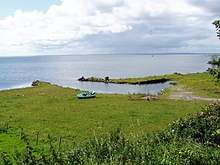
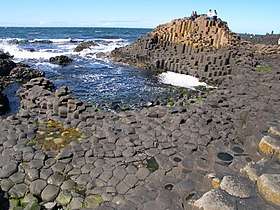
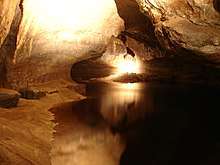
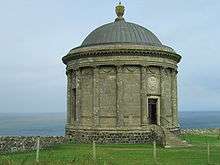
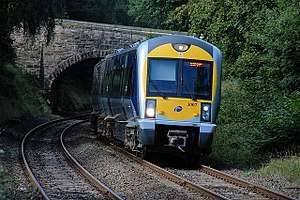
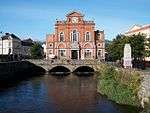
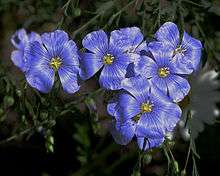


.svg.png)
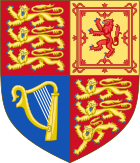
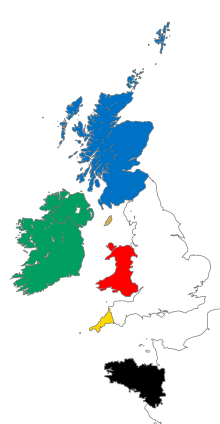
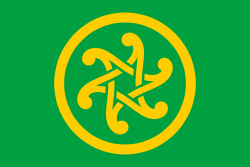
Countries.png)